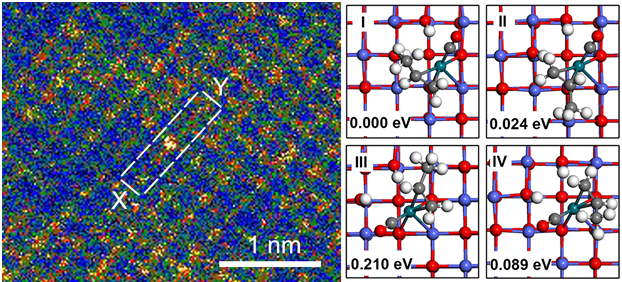Synergetic Interaction between Electronic Delocalization and Ionic Delocalization Boosts the Electrical Conductivity
The research group of Prof. Zeng from School of Chemistry and Materials Science & Hefei National Laboratory for Physical Sciences at the Microscale has focused on the rational design of catalysts and modification of their electrocatalytic properties. Recently, Zeng’s group in cooperation with Prof. Peng from the University of Akron made significant progress in engineering the electrical conductivity of the catalysts for enhanced oxygen evolution (OER). Based on the synergetic interaction between electronic delocalization and ionic delocalization, the researchers successfully enhanced the electrical conductivity of Ag-doped CoSe2 nanobelts (Ag-CoSe2 nanobelts) to achieve efficient OER. This work has been published on Angewandte Chemie International Edition (Angew. Chem. Int. Ed. 2017, 56, 328) with the title of “Engineering the Electrical Conductivity of Lamellar Silver-Doped Cobalt(II) Selenide Nanobelts for Enhanced Oxygen Evolution”.
Renewable energy sources have received growing attention owing to the massive consumption of fossil fuels and environmental pollution. With regard to the energy and environment crises, hydrogen serves as a future energy resource by virtue of the highest mass energy density and renewability. OER represents an effective approach to hydrogen generation. However, OER suffers from intrinsically sluggish kinetics because of the involvement of multiple proton-couple electron transfer steps. Although precious metal oxides are generally employed as active electrocatalysts to facilitate the sluggish kinetics, their low abundance and high cost significantly make it impractical to commercialize these electrocatalysts. Accordingly, it is attractive to develop alternative OER electrocatalysts made of earth-abundant elements, such as 3d transition metals and their derivatives. It is known that proper electron conductivity serves as a prerequisite for catalysts with remarkable electrocatalytic performance. A high electrical conductivity ensures a fast electron transfer process to reduce the Schottky barriers at both catalyst-electrolyte and catalyst-electrode interfaces. Therefore, it is of significant importance to precisely engineer the intrinsic electrical conductivity of CoSe2-based catalysts.

Ag-CoSe2 nanobelts and their OER properties
The researchers apply a facile partial cation exchange method to prepare lamellar Ag-CoSe2 nanobelts with controllable electrical conductivity for enhanced OER activity. The introduction of Ag+ cations with its content below 1.0% could enhance the conductivity of Ag-CoSe2 nanobelts. Based on the synergetic interaction between electronic delocalization and ionic delocalization, the electrical conductivity of Ag-doped CoSe2 nanobelts was significantly enhanced. Benefiting from the enhanced conductivity and retained active sites of Co2+ cations, the as-prepared Ag-CoSe2 nanobelts exhibited remarkable activity towards OER. The OER overpotential of Ag-CoSe2 nanobelts was 0.32 V at a current density of 10 mA cm−2, which was lower than that of CoSe2 nanobelts. Moreover, Ag-CoSe2 nanobelts showed a high current density of 22.36 mA cm−2 at the overpotential of 0.35 V and a small Tafel slope of 56 mV/dec relative to CoSe2 nanobelts, In addition, superior stability was also demonstrated for the Ag-CoSe2 nanobelts after long-term potential cycles. This strategy represents a rational design of efficient electrocatalysts through finely tuning their electrical conductivities.
This work was supported by CAS, MOST of China, and the National Natural Science Foundation of China.
Publication link: http://onlinelibrary.wiley.com/doi/10.1002/anie.201609080/full
Back
